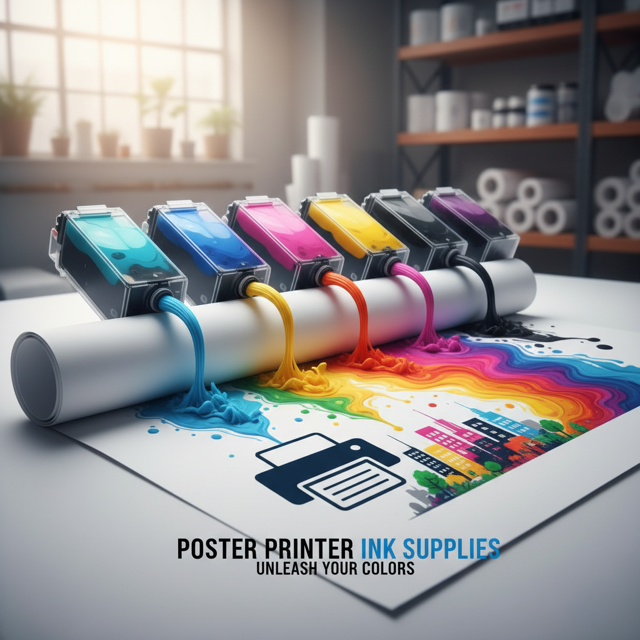
DISCOUNTED EDUCATION PRICING! CALL 1-877-891-8411. We Gladly Accept School Purchase Orders!

In a world where visuals reign supreme, posters serve as silent storytellers, captivating audiences in classrooms, boardrooms, and bustling streets. But what transforms a mere sheet of paper into a vibrant canvas of ideas? Enter poster printer ink—the unsung hero that breathes life into designs, blending science and artistry in a dance of droplets. Whether you’re a educator crafting motivational banners, a marketer unveiling product launches, or an artist immortalizing visions, understanding this magical medium can elevate your creations from ordinary to extraordinary. In this comprehensive exploration, we’ll delve into the nuances of poster printer ink, unravel its mysteries, and equip you with the wisdom to produce prints that pop. Buckle up as we journey through the inky realms, answering burning questions along the way and sprinkling in bite-sized insights to keep things lively.
At its heart, poster printer ink is a specialized formulation engineered for large-format printing, where standard office inks simply won’t cut it. Unlike the everyday cartridges in your home printer, these inks are tailored for expansive surfaces, ensuring crisp details and bold hues that withstand scrutiny from afar. Composed of pigments or dyes suspended in a carrier liquid—be it water, solvents, or advanced polymers—they interact with media like paper, vinyl, or fabric to create enduring impressions.
But why does ink matter so much for posters? Imagine a symphony where the instruments are out of tune; the result is discord. Similarly, subpar ink can lead to faded colors, smudges, or premature degradation, turning your masterpiece into a muted memory. High-quality poster ink, however, ensures longevity, vibrancy, and compatibility with diverse printers, from inkjet behemoths to eco-conscious latex systems.
Quick Snippet: Did You Know? The average poster printer ink droplet is smaller than a human hair, allowing for resolutions up to 1440 dpi—that’s like packing a high-definition movie onto a wall!
Diving deeper, the world of poster printer ink isn’t monolithic; it’s a spectrum of options, each with its own superpowers and quirks. Let’s break them down, drawing from established printing wisdom to guide your choices.
These inks dissolve colorants directly into a liquid base, often water, yielding spectacularly bright and saturated tones. Ideal for indoor posters where sunlight isn’t a foe, they excel in photo-quality prints on glossy papers. However, their Achilles’ heel is UV sensitivity—exposure can cause fading over time, making them less suitable for outdoor epics.
Pros: Affordable, seamless blending for gradients, quick-drying. Cons: Prone to water damage, shorter lifespan in bright environments.
Question: Is dye-based ink good for beginner poster makers? Absolutely! For those dipping toes into poster creation, it’s a budget-friendly entry point that delivers eye-popping results without complex setups.
Here, microscopic pigment particles are suspended rather than dissolved, creating a barrier against fading and moisture. These are the workhorses for professional posters, offering archival quality that can last decades. They’re particularly stellar for matte finishes and outdoor applications, though they might not match dye’s sheer brilliance.
Pros: Fade-resistant, water-proof once cured, versatile on various media. Cons: Slightly muted colors, potential for clogging if not maintained.
Fun Fact Snippet: Pigment inks date back to ancient cave paintings, where natural minerals provided enduring colors—modern versions just got a high-tech upgrade!
Infused with volatile organic compounds (VOCs), these inks bite into non-porous materials like vinyl, making them perfect for weather-beaten outdoor posters. They boast exceptional durability against rain and sun, but the trade-off is a pungent odor requiring ventilated spaces during printing.
Pros: Long-lasting adhesion, vibrant on banners and signs. Cons: Environmental concerns, slower drying times.
Question: When should I opt for solvent inks over others? If your poster will brave the elements—like event signage or vehicle wraps—solvent inks provide unmatched toughness, ensuring your message endures storms and scrutiny alike.
A gentler evolution of solvents, eco-variants use milder chemicals, reducing VOC emissions while retaining robustness. They’re a favorite in eco-aware studios, balancing performance with planetary kindness, and work wonders on posters for sustainable campaigns.
Pros: Low odor, eco-friendlier, durable for indoor/outdoor use. Cons: Higher cost, may require specific printers.
These inks solidify under ultraviolet light, curing in seconds for immediate handling. Versatile across rigid and flexible media, they’re ideal for textured posters or those needing scratch resistance. No drying time means faster production, but UV printers come at a premium.
Pros: Instant cure, odorless, eco-safe. Cons: Equipment-intensive, limited to UV-compatible setups.
Quick Tip Snippet: Always test UV inks on your chosen media first—mismatches can lead to adhesion woes!
Water-based with latex resins, these inks combine the best of aqueous and solvent worlds: vibrant, durable, and low-VOC. They’re odorless, making them school and office favorites for educational posters, and they adhere to a wide array of substrates without primers.
Pros: Versatile, safe for sensitive environments, quick turnaround. Cons: Initial printer investment.
Question: Are latex inks the future of poster printing? With their blend of eco-friendliness and performance, many experts predict latex will dominate, especially as regulations tighten on emissions.
From these varieties, it’s clear that no single ink reigns supreme; context is king. Whether prioritizing vibrancy, durability, or sustainability, aligning ink type with your poster’s purpose unlocks optimal results.
With a buffet of options, how do you pick the right poster printer ink without regret? Start by assessing your needs: Indoor gallery display? Go dye or pigment. Outdoor billboard? Solvent or latex shines. Budget constraints? Dye offers entry-level excellence.
Consider printer compatibility—most large-format machines specify ink types to avoid jams or voids. Media matters too: Glossy papers pair with dye for shine, while vinyl demands solvent grip.
Question: How does ink choice impact poster cost? Premium inks like UV or latex might hike upfront expenses, but their longevity reduces reprints, saving money long-term. Always calculate total ownership costs, including maintenance.
Environmental factors weigh in: For green initiatives, eco-solvent or latex minimizes footprints. Finally, test samples—many suppliers offer trials to preview outcomes.
Insight Snippet: A 2023 industry survey revealed that 65% of print pros switched to eco-friendly inks for client demands, boosting satisfaction scores by 20%!
To harness poster printer ink’s full potential, adopt rituals that ensure flawless execution. First, calibrate your printer regularly—color profiles prevent mismatches, keeping blues true and reds radiant.
Use high-quality media; cheap paper absorbs ink unevenly, dulling vibrancy. Opt for acid-free stocks for archival posters. Print in controlled environments: Humidity can cause bleeding, while dust clogs nozzles. Also, remember good quality poster paper.
Question: What’s the secret to extending ink life? Employ economy modes for drafts, store cartridges upright in cool spots, and run nozzle checks weekly. These habits can double yield, per expert guidelines.
For multi-color designs, layer inks thoughtfully—allow drying between passes to avoid muddling. And embrace software tools for optimization, reducing waste through precise layouts.
Pro Tip Snippet: Avoid dark backgrounds on large posters; they guzzle ink like a thirsty camel, spiking costs without proportional impact.
No ink journey is without bumps. Common woes include clogs from dried residues—combat with routine cleanings using manufacturer kits. Streaks? Misaligned heads; realign via printer software.
Faded prints signal expired ink or low-quality batches—always check dates and buy from reputable sources. For solvent users, ventilation prevents health hazards.
Question: How do I fix ink smudges on fresh posters? Patience is key; allow full curing time—up to 24 hours for water-based inks—before handling or stacking.
Regular firmware updates keep printers humming, while professional servicing every 6-12 months averts major meltdowns.
Warning Snippet: Never mix ink types in one printer; it’s like oil and water—disastrous separation ensues!
Let’s tackle the queries that keep poster enthusiasts up at night.
Q: How many posters can I expect from a full ink set? A: It varies by printer and design density, but typically 40-100 posters. Light-coverage designs stretch further, while ink-heavy graphics consume more.
Q: Is there a difference between home and professional poster inks? A: Yes—professional inks emphasize durability and scale, with formulations for wide-format efficiency, unlike home inks focused on small prints.
Q: Can I use expired ink for posters? A: Risky! It may clog or fade unevenly. Fresh ink ensures reliability.
Q: What’s the environmental impact of poster inks? A: Traditional solvents contribute VOC’s, but switching to latex or eco-solvent cuts emissions by up to 90%, promoting greener printing.
Q: How do I store unused ink cartridges? A: In sealed bags, away from light and extremes—think 50-70°F for optimal preservation.
Q: Are there inks for fabric posters? A: Sublimation inks excel here, embedding colors via heat for washable, vibrant textiles.
Curiosity Snippet: Ancient Egyptians used soot-based inks for papyrus posters—today’s versions are light-years ahead, yet echo that inventive spirit!
Q: Why does my poster ink bleed on certain papers? A: Porosity mismatch; choose coated papers for sharp edges.
Q: Can poster inks be recycled? A: Many cartridges are recyclable—check programs from brands like Canon or HP.
Q: What’s the costliest mistake with poster ink? A: Ignoring calibration, leading to reprints and wasted resources.
Q: How has ink technology evolved for posters? A: From toxic solvents to bio-based formulas, innovation focuses on sustainability without sacrificing quality.
These answers stem from years of poster printing lore, ensuring you’re armed for success.
As we conclude this deep dive into poster printer ink and poster printer supplies remember: This elixir isn’t just a commodity; it’s the alchemist’s stone turning visions into tangible triumphs. By selecting the right type, adhering to best practices, and troubleshooting proactively, you’ll craft posters that inspire, inform, and endure. Whether igniting classroom curiosity or dominating trade shows, let your ink choices reflect your commitment to excellence.
Embrace experimentation, stay updated on innovations, and always prioritize quality. Your next poster could be the one that changes perspectives—ink it wisely!